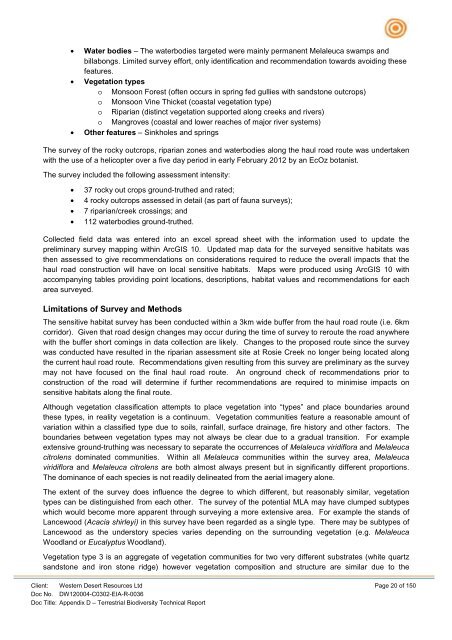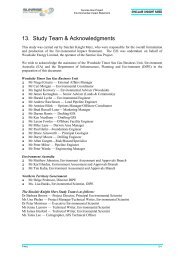Appendix D Terrestrial and Aquatic Biodiversity - Environment ...
Appendix D Terrestrial and Aquatic Biodiversity - Environment ...
Appendix D Terrestrial and Aquatic Biodiversity - Environment ...
You also want an ePaper? Increase the reach of your titles
YUMPU automatically turns print PDFs into web optimized ePapers that Google loves.
• Water bodies – The waterbodies targeted were mainly permanent Melaleuca swamps <strong>and</strong><br />
billabongs. Limited survey effort, only identification <strong>and</strong> recommendation towards avoiding these<br />
features.<br />
• Vegetation types<br />
o Monsoon Forest (often occurs in spring fed gullies with s<strong>and</strong>stone outcrops)<br />
o Monsoon Vine Thicket (coastal vegetation type)<br />
o Riparian (distinct vegetation supported along creeks <strong>and</strong> rivers)<br />
o Mangroves (coastal <strong>and</strong> lower reaches of major river systems)<br />
• Other features – Sinkholes <strong>and</strong> springs<br />
The survey of the rocky outcrops, riparian zones <strong>and</strong> waterbodies along the haul road route was undertaken<br />
with the use of a helicopter over a five day period in early February 2012 by an EcOz botanist.<br />
The survey included the following assessment intensity:<br />
• 37 rocky out crops ground-truthed <strong>and</strong> rated;<br />
• 4 rocky outcrops assessed in detail (as part of fauna surveys);<br />
• 7 riparian/creek crossings; <strong>and</strong><br />
• 112 waterbodies ground-truthed.<br />
Collected field data was entered into an excel spread sheet with the information used to update the<br />
preliminary survey mapping within ArcGIS 10. Updated map data for the surveyed sensitive habitats was<br />
then assessed to give recommendations on considerations required to reduce the overall impacts that the<br />
haul road construction will have on local sensitive habitats. Maps were produced using ArcGIS 10 with<br />
accompanying tables providing point locations, descriptions, habitat values <strong>and</strong> recommendations for each<br />
area surveyed.<br />
Limitations of Survey <strong>and</strong> Methods<br />
The sensitive habitat survey has been conducted within a 3km wide buffer from the haul road route (i.e. 6km<br />
corridor). Given that road design changes may occur during the time of survey to reroute the road anywhere<br />
with the buffer short comings in data collection are likely. Changes to the proposed route since the survey<br />
was conducted have resulted in the riparian assessment site at Rosie Creek no longer being located along<br />
the current haul road route. Recommendations given resulting from this survey are preliminary as the survey<br />
may not have focused on the final haul road route. An onground check of recommendations prior to<br />
construction of the road will determine if further recommendations are required to minimise impacts on<br />
sensitive habitats along the final route.<br />
Although vegetation classification attempts to place vegetation into “types” <strong>and</strong> place boundaries around<br />
these types, in reality vegetation is a continuum. Vegetation communities feature a reasonable amount of<br />
variation within a classified type due to soils, rainfall, surface drainage, fire history <strong>and</strong> other factors. The<br />
boundaries between vegetation types may not always be clear due to a gradual transition. For example<br />
extensive ground-truthing was necessary to separate the occurrences of Melaleuca viridiflora <strong>and</strong> Melaleuca<br />
citrolens dominated communities. Within all Melaleuca communities within the survey area, Melaleuca<br />
viridiflora <strong>and</strong> Melaleuca citrolens are both almost always present but in significantly different proportions.<br />
The dominance of each species is not readily delineated from the aerial imagery alone.<br />
The extent of the survey does influence the degree to which different, but reasonably similar, vegetation<br />
types can be distinguished from each other. The survey of the potential MLA may have clumped subtypes<br />
which would become more apparent through surveying a more extensive area. For example the st<strong>and</strong>s of<br />
Lancewood (Acacia shirleyi) in this survey have been regarded as a single type. There may be subtypes of<br />
Lancewood as the understory species varies depending on the surrounding vegetation (e.g. Melaleuca<br />
Woodl<strong>and</strong> or Eucalyptus Woodl<strong>and</strong>).<br />
Vegetation type 3 is an aggregate of vegetation communities for two very different substrates (white quartz<br />
s<strong>and</strong>stone <strong>and</strong> iron stone ridge) however vegetation composition <strong>and</strong> structure are similar due to the<br />
Client: Western Desert Resources Ltd Page 20 of 150<br />
Doc No. DW120004-C0302-EIA-R-0036<br />
Doc Title: <strong>Appendix</strong> D – <strong>Terrestrial</strong> <strong>Biodiversity</strong> Technical Report



